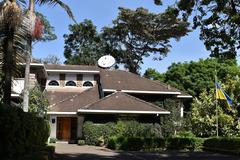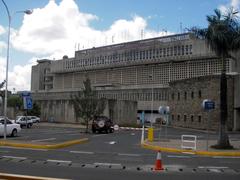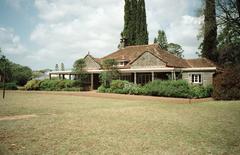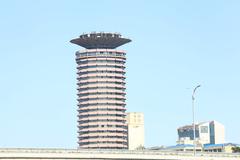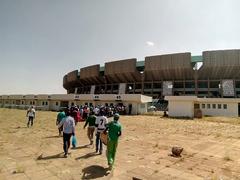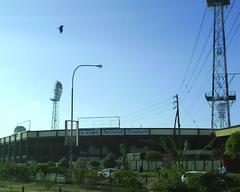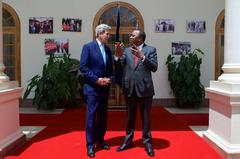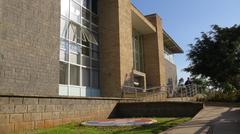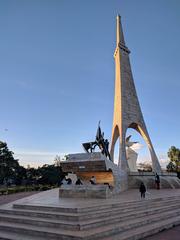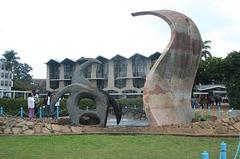Complete Guide to Visiting Nairobi National Museum, Nairobi, Kenya
Publication Date: 17/07/2024
Introduction to Nairobi National Museum
The Nairobi National Museum, located in the bustling heart of Nairobi, Kenya, serves as a vital repository of the nation’s rich cultural and natural heritage. Established in 1910 by the East Africa and Uganda Natural History Society (EAUNHS), the museum was initially created to house and preserve the region’s vast array of flora and fauna. Over the decades, it has evolved into a multifaceted institution that not only showcases Kenya’s biodiversity but also delves into its intricate history and diverse cultural practices. The museum’s location on Museum Hill, easily accessible from Nairobi’s city center, makes it a prime destination for tourists and researchers alike. Visitors can explore an impressive array of exhibits ranging from ancient fossils, such as the Turkana Boy, to contemporary art installations. The museum complex also includes the Nairobi Snake Park and lush botanical gardens, enhancing the overall visitor experience (National Museums of Kenya). With its state-of-the-art facilities and comprehensive educational programs, the Nairobi National Museum plays a crucial role in fostering a deeper appreciation of Kenya’s past and present. This guide aims to provide you with all the essential information needed for a memorable visit, including visiting hours, ticket prices, and travel tips, as well as an overview of the museum’s most notable exhibits and its broader cultural and social impact.
Table of Contents
- [Introduction](#introductionintroduction-to-nairobi-national-museum)
- [History and Significance](#history-and-significancehistory-and-significance)
- [Origins and Establishment](#origins-and-establishmentorigins-and-establishment)
- [Architectural Evolution](#architectural-evolutionarchitectural-evolution)
- [Collections and Exhibits](#collections-and-exhibitscollections-and-exhibits)
- [Natural History](#natural-historynatural-history)
- [Cultural Artifacts](#cultural-artifactscultural-artifacts)
- [Contemporary Art](#contemporary-artcontemporary-art)
- [The Hall of Kenya](#the-hall-of-kenyathe-hall-of-kenya)
- [The Cradle of Humankind](#the-cradle-of-humankindthe-cradle-of-humankind)
- [The Birds of East Africa](#the-birds-of-east-africathe-birds-of-east-africa)
- [The Cycles of Life](#the-cycles-of-lifethe-cycles-of-life)
- [The History of Kenya](#the-history-of-kenyathe-history-of-kenya)
- [The Mammals of Kenya](#the-mammals-of-kenyathe-mammals-of-kenya)
- [The Geology Gallery](#the-geology-gallerythe-geology-gallery)
- [The Snake Park](#the-snake-parkthe-snake-park)
- [The Temporary Exhibitions](#the-temporary-exhibitionsthe-temporary-exhibitions)
- [The Botanical Gardens](#the-botanical-gardensthe-botanical-gardens)
- [Visitor Information](#visitor-informationvisitor-information)
- [Visiting Hours](#visiting-hoursvisiting-hours)
- [Ticket Prices](#ticket-pricesticket-prices)
- [Guided Tours](#guided-toursguided-tours)
- [Travel Tips](#travel-tipstravel-tips)
- [Nearby Attractions](#nearby-attractionsnearby-attractions)
- [Educational and Research Significance](#educational-and-research-significanceeducational-and-research-significance)
- [Educational Programs](#educational-programseducational-programs)
- [Research Contributions](#research-contributionsresearch-contributions)
- [Cultural and Social Impact](#cultural-and-social-impactcultural-and-social-impact)
- [Promoting National Pride](#promoting-national-pridepromoting-national-pride)
- [Tourist Attraction](#tourist-attractiontourist-attraction)
- [Conservation and Future Prospects](#conservation-and-future-prospectsconservation-and-future-prospects)
- [Conservation Efforts](#conservation-effortsconservation-efforts)
- [Future Developments](#future-developmentsfuture-developments)
- [FAQ](#faqfaq)
- [Conclusion](#conclusionconclusion)
- [Sources and References](#sources-and-referencessources-and-references)
History and Significance
Origins and Establishment
The museum’s origins date back to 1910 when the East Africa and Uganda Natural History Society (EAUNHS) was formed by enthusiastic naturalists. Their primary goal was to collect and preserve specimens of the region’s flora and fauna. The society’s efforts led to the establishment of a museum in 1910, initially housed in a small building in Nairobi.
In 1929, the museum was relocated to its current site on Museum Hill, offering easier access to visitors. The new building was officially opened in 1930 and has since undergone several expansions and renovations.
Architectural Evolution
The Nairobi National Museum’s architecture has evolved to meet the changing needs of its collections and visitors. The original colonial-style building has been expanded and modernized over the years. Significant renovations in the early 2000s culminated in the reopening of the museum in 2008, featuring state-of-the-art exhibition spaces, research facilities, and visitor amenities.
Collections and Exhibits
Natural History
The natural history section boasts an extensive collection of fossils, geological specimens, and taxidermy animals, providing insights into Kenya’s rich biodiversity. Notable exhibits include the “Hominid Vault,” which houses famous fossil remains of early human ancestors like the Turkana Boy and Australopithecus anamensis.
Cultural Artifacts
The cultural section showcases artifacts from Kenya’s various ethnic groups, highlighting their unique traditions, crafts, and lifestyles. Visitors can explore exhibits on traditional clothing, tools, and musical instruments, gaining a deeper understanding of Kenya’s cultural diversity.
Contemporary Art
The museum also features a contemporary art gallery, hosting rotating exhibitions of works by Kenyan and international artists. This space provides a platform for artists to engage with the public and explore contemporary issues through their art.
The Hall of Kenya
The Hall of Kenya offers a comprehensive overview of Kenya’s rich cultural and natural heritage. This exhibit is divided into several sections, each focusing on different aspects of Kenya’s history and biodiversity. Visitors can explore detailed displays on the country’s diverse ecosystems, including the Great Rift Valley, savannas, and coastal regions.
The Cradle of Humankind
One of the most significant exhibits at the Nairobi National Museum is the Cradle of Humankind. This section is dedicated to the prehistoric era and showcases some of the most important fossil discoveries in human evolution. The exhibit includes the famous Turkana Boy, a nearly complete skeleton of a Homo erectus youth discovered near Lake Turkana (National Museums of Kenya).
The Birds of East Africa
The Birds of East Africa exhibit is a must-see for ornithology enthusiasts. This section features an impressive collection of over 900 bird specimens, representing the diverse avian species found in the region. The exhibit is organized by habitat, allowing visitors to learn about the different bird species that inhabit Kenya’s forests, wetlands, savannas, and coastal areas (BirdLife International).
The Cycles of Life
The Cycles of Life exhibit explores the various stages of life and the cultural practices associated with them in different Kenyan communities. This exhibit is divided into sections that focus on birth, initiation, marriage, and death, highlighting the rituals and ceremonies that mark these important life events (Kenya Cultural Centre).
The History of Kenya
The History of Kenya exhibit provides a chronological overview of the country’s past, from ancient times to the present day. This section is divided into several galleries, each focusing on a different period in Kenya’s history. Visitors can view a wide range of artifacts, including historical documents, photographs, and personal items belonging to key figures in Kenya’s history (Kenya National Archives).
The Mammals of Kenya
The Mammals of Kenya exhibit showcases the incredible diversity of mammalian species found in the country. This section features life-sized models and mounted specimens of various mammals, from the iconic African elephant and lion to lesser-known species such as the aardvark and the suni antelope (Kenya Wildlife Service).
The Geology Gallery
The Geology Gallery at the Nairobi National Museum offers a fascinating look at the geological history of Kenya. This exhibit features an extensive collection of rocks, minerals, and fossils, showcasing the country’s rich geological diversity (Geological Society of Kenya).
The Snake Park
Adjacent to the Nairobi National Museum is the Snake Park, a popular attraction for visitors interested in herpetology. The Snake Park features a wide variety of snake species, both venomous and non-venomous, native to Kenya and other parts of Africa (Nairobi Snake Park).
The Temporary Exhibitions
The Nairobi National Museum hosts a variety of temporary exhibitions throughout the year. These exhibitions cover a wide range of topics, from contemporary art and photography to historical artifacts and scientific discoveries (National Museums of Kenya).
The Botanical Gardens
The Nairobi National Museum is also home to beautiful botanical gardens, which offer a peaceful retreat from the bustling city. The gardens feature a wide variety of indigenous and exotic plant species, including medicinal plants, succulents, and ornamental flowers (Nairobi Botanic Garden).
Visitor Information
Visiting Hours
The museum is open daily from 8:30 AM to 5:30 PM, including weekends and public holidays.
Ticket Prices
Admission fees are affordable, with special rates for children, students, and groups. Combined tickets for the museum and the Nairobi Snake Park are also available, offering a comprehensive experience of Kenya’s natural heritage. As of July 2024, the entrance fees are as follows:
- Adults (Residents): KES 200
- Adults (Non-Residents): USD 10
- Children (Residents): KES 100
- Children (Non-Residents): USD 5
Guided Tours
Tourists are encouraged to take advantage of the guided tours offered by the museum for in-depth insights into the exhibits. These tours are available in multiple languages, including English, Swahili, and French (National Museums of Kenya).
Travel Tips
To make the most of their visit, tourists should consider visiting during off-peak hours to avoid crowds. The museum complex includes the Nairobi Snake Park, which houses a variety of reptiles and amphibians.
Nearby Attractions
Other nearby attractions include the Kenya National Theatre and the Nairobi Arboretum, both of which are within walking distance of the museum.
Educational and Research Significance
Educational Programs
The museum offers educational programs and workshops for schools and the general public, fostering a deeper appreciation of Kenya’s heritage and promoting conservation efforts (National Museums of Kenya).
Research Contributions
The museum’s research department conducts studies in various fields, including paleontology, archaeology, and ethnography, contributing to the global body of knowledge.
Cultural and Social Impact
Promoting National Pride
The museum’s exhibits and programs celebrate Kenya’s diverse heritage, promoting understanding and respect among different communities and instilling a sense of identity and belonging among Kenyans.
Tourist Attraction
The museum is a popular destination for both local and international visitors, contributing to Kenya’s economy and promoting tourism.
Conservation and Future Prospects
Conservation Efforts
The museum’s conservation department works tirelessly to preserve and protect its collections, ensuring they remain accessible to future generations. Collaborations with local and international organizations on conservation projects further these efforts (National Museums of Kenya).
Future Developments
Future plans include the expansion of collections, enhancement of facilities, digitization of collections, and the introduction of interactive and multimedia exhibits.
FAQ
Common Visitor Questions
-
What are the Nairobi National Museum visiting hours?
- The museum is open daily from 8:30 AM to 5:30 PM.
-
How much are the Nairobi National Museum tickets?
- Admission fees vary, with special rates for children, students, and groups. As of July 2024, tickets are KES 200 for resident adults, USD 10 for non-resident adults, KES 100 for resident children, and USD 5 for non-resident children.
-
Are guided tours available at the museum?
- Yes, guided tours offer in-depth insights into the exhibits. These tours are available in multiple languages, including English, Swahili, and French.
Conclusion
The Nairobi National Museum stands as a testament to Kenya’s rich and diverse heritage, offering an immersive experience that spans from prehistoric times to contemporary cultural expressions. Its extensive collections, ranging from the Hominid Vault to the Birds of East Africa exhibit, provide invaluable insights into the natural history and cultural practices of the region. The museum’s commitment to education and research, evident through its various programs and workshops, underscores its role as a cornerstone of both local and global academic endeavors. Visitors are encouraged to take advantage of the guided tours to gain deeper insights into the exhibits, and to explore nearby attractions such as the Nairobi Snake Park and the Nairobi Arboretum for a more comprehensive experience (National Museums of Kenya). The institution’s ongoing conservation efforts and future plans for expansion and digitization ensure that it will continue to be a vital resource for generations to come. Whether you’re a history enthusiast, a nature lover, or simply looking to explore the cultural richness of Kenya, the Nairobi National Museum offers a unique and enriching experience that shouldn’t be missed. Plan your visit today and delve into the wonders of Kenya’s past and present.
Sources and References
- National Museums of Kenya. (n.d.). Nairobi National Museum. Retrieved from https://www.museums.or.ke/nairobi-national-museum/
- BirdLife International. (n.d.). Birds of East Africa. Retrieved from https://www.birdlife.org
- Kenya Cultural Centre. (n.d.). The Cycles of Life. Retrieved from https://www.kenyaculturalcentre.go.ke
- Kenya National Archives. (n.d.). The History of Kenya. Retrieved from https://www.archives.go.ke
- Kenya Wildlife Service. (n.d.). The Mammals of Kenya. Retrieved from https://www.kws.go.ke
- Geological Society of Kenya. (n.d.). The Geology Gallery. Retrieved from https://www.geology.or.ke
- Nairobi Botanic Garden. (n.d.). The Botanical Gardens. Retrieved from https://www.nairobibotanicgarden.org
- Nairobi Snake Park. (n.d.). The Snake Park. Retrieved from https://www.museums.or.ke/nairobi-snake-park/
